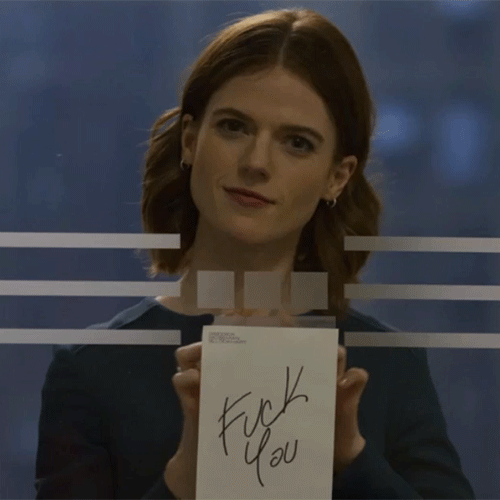
What is the good fight?
That seems like a fair question to ask of a show called The Good Fight, and for an answer, I’m going to turn to James Woods in the 1989 courtroom drama True Believer. In True Believer, Woods stars as a burnout lawyer who was once a great activist in the late ’60s, but now mostly smokes pot and defends lowlifes who pay in cash. Robert Downey Jr. is more of an idealist, a recent law-school grad who asks Woods to take on the case of a young Korean man in prison, perhaps wrongfully, for a gang-related murder. In the money scene, Downey seems resigned to the likelihood of defeat, and the best they can hope for is a good fight, so at least they can go down swinging. Woods’s response is memorably apoplectic: “Don’t give me that liberal yuppie bullshit about a good fight. This isn’t fucking Yale. A good fight is one you win!”
Diane mentions “the good fight” in her last scene in “The One Where Diane Joins the Resistance,” in which she’s speaking in front of a splinter group of fellow liberals who aren’t satisfied with more conventional means of protest. The other side is fighting dirty, with a network of Russian troll farms coming to life during election season, pumping fake news through fake users to real people on social-media sites like Facebook and Twitter. Perhaps the proper course is to transcend Trumpism by appealing to people’s better selves — the “they go low, we go high” approach adopted by the Obamas. That would place an emphasis on the “good” in “good fight,” in that activists can feel like they’ve done the right thing, whether the results are favorable or not.
But Diane’s thinking has shifted to Woods’s perspective in True Believer. (That the real-life Woods has turned into a far-right Twitter troll is funny to consider, though the contempt he injects into the phrase “liberal yuppie bullshit” suggests he was already well on his way then.) She’s been in the legal trenches long enough to understand that winning is paramount, even if it means making some soul-coarsening compromises along the way. She recognizes that sitting in a meeting alongside resistance activists who are promoting an ineffectual video and arguing over the primacy of single-payer health care or climate change isn’t her role to play. So when she’s recruited into a clandestine cell by a woman promoting herself as a former oppo tactician for Obama, Diane is intrigued. She has a chance to fight dirty. Fighting dirty isn’t good in the moral sense. But the good fight is one you win.
Diane’s thinking is reinforced by a late-night encounter with Roland Blum, who’s a star graduate of the Roy Cohn/Roger Stone school of dirty-tricksterism. Blum mocks the notion of the arc of history bending toward justice, dismissing the notion that Trump is merely a speed bump on the road to enlightenment. “He likes his job,” says Blum. “He wants a third term.” Diane believes the people will rise up against him, but Blum isn’t convinced, especially if unemployment numbers remain low. Voters may not care that much about preserving democracy. “Trump wins because he sees life as a battle, not a cause,” Blum tells Diane. “He uses your strength against you. Liberals never get that.”
“The One Where Diane Joins the Resistance” is a complex and delectably feisty episode about the benefits and hidden costs of fighting fire with fire. For Diane, that means joining a resistance cell that works to expose a troll farm on Randolph Street by spreading fake news about it. For Maia, who’s been tethered to Blum in a conspiratorial murder case, that means undermining her unctuous partner and taking a favorable plea deal for her client, leaving his client to take the fall instead. In both situations, there are short-term gains and long-term concerns: Diane feels the thrill of the fake-news scheme working and the troll farm closing over its phony pedophile-ring story (shades of Pizzagate), but discovers that the ringleader is a con artist and identity thief who targets rich women just like her. (She also lands on the NSA’s radar, but she doesn’t know that yet.) Maia successfully screws Blum over, but he gets her arrested in the end for the purloined hospice care box that he left in the backseat of her car.
The show doesn’t come to any set conclusions on whether Diane and Maia did the right thing — or, rather, whether doing the wrong thing was the right thing. There’s blowback to the by-any-means-necessary approach that neither of them can anticipate, and that may turn their temporary victories into a substantial losses. We’ve seen that happen recently with the actual Roger Stone, whose tactics led to an FBI raid on his home in Fort Lauderdale and a reprimand from a judge who wasn’t happy to be put in the crosshairs on his Instagram page. Maia’s arrest on drug charges appears to be Blum playing the lone trump card in hand, but her transformation into a ruthless, “What the fuck are you looking at?” type could send her down the wrong path. It’s great for the show, which has been needing to breathe fresh life into the character, but becoming Roland Blum is not a great aspirational track for anyone.
As for Diane, she’s unchastened by the con artist who recruited her. She is ready to continue to wrestle with pigs, even if they both get dirty and the pig likes it. She doesn’t know about the long-term trouble she’s inviting from the NSA — neither does Jay, who’s now inadvertently in the mix — but she will keep chasing that satisfying feeling she’s doing something tangible to end Trumpism, which has trailed her all the way into her bedroom. The show, with its propensity for wild risk-taking, has taken the wild risk of having Diane operate outside the business of the firm itself, as if she’s on another show about political ratfucking. On any other series, this subplot would seem like going off the rails. But The Good Fight, god bless it, was never on the rails from the start.
Hearsay:
• Maia’s glorious heel-turn earns “GIF of the week” status. Here she is after stealing an office from another third-year, and really not caring that the previous occupant is upset about it. (This GIF has extraordinary, wide-ranging applications and powers. Use responsibly.)
• Some absolutely scabrous Blum one-liners this episode, as he tours the law offices of Reddick, Boseman. On the front-desk artwork: “Did the United Negro College Fund have a bake sale? That painting is fucking hideous.” And on Maia’s desk among many in the open office plan: “Did I volunteer to man the phones at a teen suicide hotline?” In making a plea to another third-year associate to take her closed office instead: “Little Maia here can’t get through the day without masturbating.”
• The other major subplot this episode has Lucca taking divorce business from Liz, who may or may not have shared prenup-voiding intimacies with Adrian. Some satisfying courtroom intrigue, but the resolution is where it really packs a punch: Turns out that $400,000 in secret payments to Carl Reddick’s women have to be protected at all costs, underlining the show’s thinking about the insidiousness of NDAs in covering for executive sexual misconduct. Even beyond the grave, in this case.
• Always a treat when The Good Wife and The Good Fight allow the entire first act to unfold before the opening credits. Here the wait is a full 15 minutes.
• The Jonathan Coulton animated explainers continue to be catchy, witty, and informative bits of wordplay. The opening lines to this week’s number on Russian troll farms: “In a city with a name I don’t know how to pronounce / with a lot of fake Facebook and Twitter accounts / in a windowless room lit by the glow of the screen / there’s a weaponized information garbage machine.”
• Ending Blum’s run with a shot of him singing “I’ll Be There” against various karaoke backdrops is an inspired, zany touch. And a reminder that he and his tactics — and, by implication, Trump and his tactics — will continue after he’s gone.



